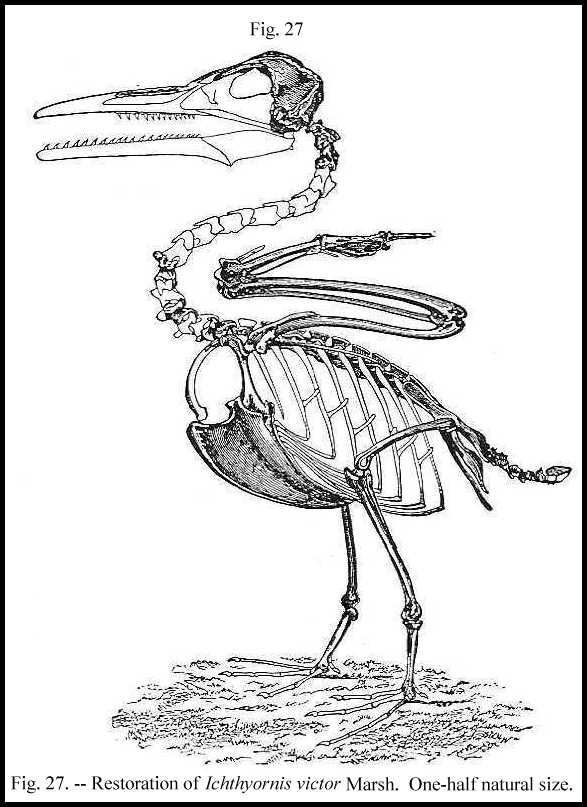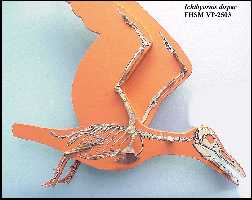
Marsh, O. C.
1872
Notice of a new and remarkable fossil bird.
American Journal of Science, series 3, 4(22):344.
 |
Marsh, O. C. 1872 Notice of a new and remarkable fossil bird.
American Journal of Science, series 3, 4(22):344.
Copyright © 2002-2008 by Mike EverhartPage created 03/16/2002; Last updated 02/14/2009 |
Wherein O. C. Marsh announces the discovery of a bird from the Cretaceous of Kansas. Unfortunately, although the toothed lower jaws were found with the rest of the skeleton, Marsh concluded that they belonged to an as-yet undescribed marine reptile. See: Marsh, O. C., 1872. Notice of a new reptile from the Cretaceous. American Journal of Science, series 3, 4(23):406. It was several months later when Marsh finally realized that the jaws were part of the bird remains (Marsh, 1873).
| 344
O. C. Marsh - New Fossil Bird. Notice of a New and Remarkable Fossil Bird; by O. C. MARSH. One of the most interesting of recent discoveries in Paleontology is the skeleton of a fossil bird, found, during the past summer, in the upper Cretaceous shale of Kansas, by Prof. B. F. Mudge, who has kindly sent the specimen to me for examination. The remains indicate an aquatic bird, about as large as a pigeon, and differing widely from all known birds in having biconcave vertebrę. The cervical, dorsal, and caudal vertebrę preserved all show this character, the ends of the centra resembling those in Plesiosaurus. The rest of the skeleton presents no marked deviation from the ordinary avian type. The wings were large in proportion to the posterior extremities. The humerus is 58.6 mm. in length, and has the radial crest strongly developed. The femur is small, and has the proximal end compressed transversely. The tibia is slender, and 44.5 mm. long. Its distal end is incurved, as in swimming birds, has no supratendinal ridge. This species may be called Ichthyornis dispar. A complete description will appear in an early number of this journal. Yale College, Sept. 26th, 1872. |
The teeth and manner of replacement was described in: Marsh, O. C., 1883.
Birds with Teeth. 3rd Annual Report of the Secretary of the Interior, 3: 43-88. Government
Printing Office, Washington, D.C., page 73:
"In the lower teeth of Ichthyornis, the pulp-cavity passes well up into the
base of the crown. The fang is compressed, and directed downward and forward. It is firmly
set in a deep socket, which it nearly or quite fills. The dental succession took place
vertically, as in Crocodiles and Dinosaurs; not laterally as in Hesperornis and
the Mosasaurs, a fact of no little significance. The young teeth are much inclined when
they first appear above the jaw, after the old teeth have been expelled."
 |
Left: A nearly complete specimen of Ichthyornis
(FHSM VP-2503) on exhibit in the Sternberg Museum of Natural History. This specimen was
found by J. D. Stewart in 1970 in the Smoky Hill Chalk of Graham County, near Bogue,
Kansas (For more information, see Martin and Stewart, 1977). For more pictures of Ichthyornis, visit the Sternberg Museum virtual tour page and the Smoky Hill Chalk Field Guide Pteranodons and Birds page |
Suggested references on Cretaceous birds:
Bühler, P., L. D. Martin and L. M. Witmer. 1988. Cranial kinesis in the Late Cretaceous birds Hesperornis and Parahesperornis. Auk 105 p. 111-122.
Chinsamy, A., L. D. Martin and P. Dodson. 1998. Bone microstructure of the diving Hesperornis and the volant Ichthyornis from the Niobrara Chalk of western Kansas. Cret. Research 19:225-235.Clarke, J. A.
2004. Morphology, phylogenetic taxonomy, and systematics of Ichthyornis and Apatornis (Avialae: Ornithurae). Bulletin of the American Museum of Natural History 286: 1-179.Gingerich, P. D. 1973. Skull of Hesperornis and early evolution of birds. Nature 243: 70-73
Gregory, J. T. 1951. Convergent evolution: The jaws of Hesperornis and the mosasaurs, Evolution, 5:345-354.
Gregory, J. T. 1952. The jaws of the Cretaceous toothed birds Ichthyornis and Hesperornis. Condor 54(2):73-88, 9 figs., 1 table.
Lane, H. H. 1946, A survey of the fossil vertebrates of Kansas, Part IV, The Birds, Kansas Academy Science, Transactions 49(4):390-400.
Lucas, S. G. 1982. Ichthyornis in the Late Cretaceous Mancos Shale (Juana Lopez Member), Northwest New Mexico. Journal of Paleontology 56(2):545-547.
Marsh, O. C. 1870. [Cretaceous and Tertiary birds of the U.S.] Nature (London), 1:546.
Marsh, O. C. 1872. Discovery of a remarkable fossil bird. American Journal of Science, series 3, 3(13):56-57. (for January - Hesperornis)
Marsh, O. C. 1872. Preliminary description of Hesperornis regalis, with notices of four other new species of Cretaceous birds. American Journal of Science, series 3, 3(17):360-365.
Marsh, O. C. 1872. Notice of a new and remarkable fossil bird. American Journal of Science, series 3, 4(22):344. (Ichthyornis)
Marsh, O. C. 1872. Notice of a new reptile from the Cretaceous. American Journal of Science, series 3, 4(23):406.
Marsh, O. C. 1873. Fossil birds from the Cretaceous of North America.
American Journal of Science, series 3, 5(27):229-231.
Marsh, O. C. 1875. On the Odontornithes, or birds with teeth. American
Journal of Science, series 3, 10(59):403-408, pl. 9-10.
Marsh, O. C. 1875. Odontornithes, or birds with teeth. American Naturalist. 9(12):625-631, pl. 2-3.
Marsh, O. C.
1880. Odontornithes: A monograph on the extinct toothed birds of North America. U.S. Geological Expl. 40th Parallel (King), vol. 7, xv + 201 p., 34 pl. (Synopsis of American Cretaceous birds, appendix 191-199)Marsh, O. C. 1883. Birds with Teeth. 3rd Annual Report of the Secretary of the Interior, 3: 43-88. Government Printing Office, Washington, D.C.
Martin, J. E.
1982. The occurrence of Hesperornis in the late Cretaceous Niobrara Formation of South Dakota. Proceedings South Dakota Academy of ScienceMartin, L. D. 1981. The skeleton of Baptornis advenus from the Cretaceous of Kansas, Smithsonian Contributions Paleobiology 27:36-66.
Martin, L. D. 1984. A new hesperornithid and the relationships of the Mesozoic birds. Kansas Academy Science, Transactions 87:141-150.
Martin, L. D., and J. D. Stewart. 1977. Teeth in Ichthyornis (Class: Aves). Science, 185(4284):1331-1332.
Martin, L. D. and J. D. Stewart. 1982. An ichthyornithiform bird from the Campanian of Canada. Canadian Journal of Earth Science 324-327.
Martin, L. D. and J. D. Stewart. 1996. Implantation and replacement of bird teeth. Smithsonian Contributions to Paleobiology 89:295-300.
Martin, L. D. and J. Tate Jr. 1966. A bird with teeth. Museum Notes, University of Nebraska State Museum, 29:1-2.
Walker, M. V. 1967. Revival of interest in the toothed birds of Kansas. Kansas Academy of Science, Transactions 70(1):60-66.
Williston, S. W. 1898. Addenda to Part I. The University Geological Survey of Kansas, 4:28-32.
Williston, S. W. 1898. Birds. The University Geological Survey of Kansas, Part II, 4:43-53, pls.5-8.